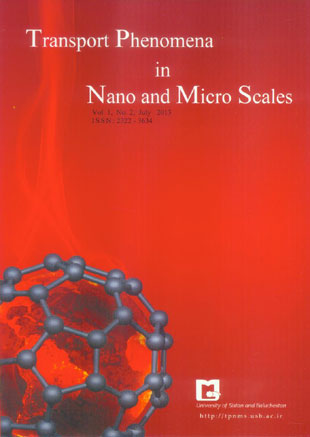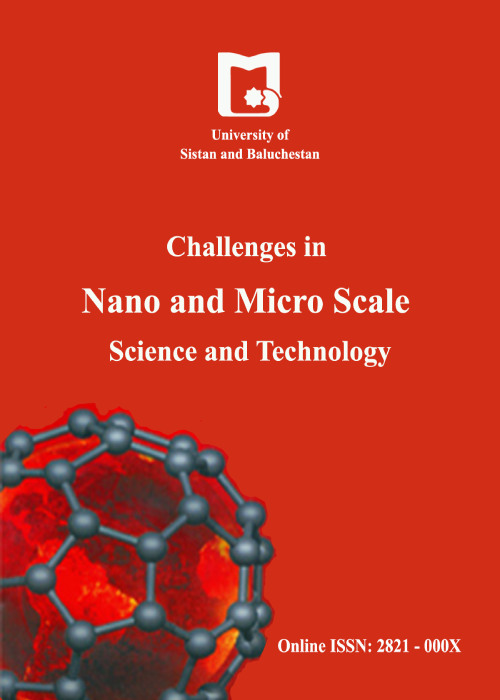فهرست مطالب

Journal of Transport Phenomena in Nano and Micro Scales
Volume:1 Issue: 2, Summer - Autumn 2013
- تاریخ انتشار: 1392/08/03
- تعداد عناوین: 7
-
-
Pages 75-92In this paper, mixed convection of Al2O3-EG-Water nanofluid in a square lid-driven enclosure is investigated numerically. The focus of this study is on the effects of variable thermophysical properties of the nanofluid on the heat transfer characteristics. The top moving and the bottom stationary horizontal walls are insulated, while the vertical walls are kept at different constant temperatures. The study is carried out for Richardson numbers of 0.01–1000, the solid volume fractions of 0–0.05 and the Grashof number of 104. The transport equations are solved numerically with a finite volume approach using the SIMPLER algorithm. The results show that the Nusselt number is mainly affected by the viscosity, density and conductivity variations. For low Richardson numbers, although viscosity increases by increasing the nanoparticles volume fraction, due to high intensity convection of enhanced conductivity nanofluid, the average Nusselt number increases for both constant and variable cases. However, for high Richardson numbers, as the volume fraction of nanoparticles increases heat transfer enhancement occurs for the constant properties cases but deterioration in heat transfer occurs for the variable properties cases. The distinction is due to underestimation of viscosity of the nanofluid by the constant viscosity model in the constant properties cases and states important effects of temperature dependency of thermophysical properties, in particular the viscosity distribution in the domain.Keywords: Nanofluid, Variable properties, Mixed convection, Ethylene glycol
-
Pages 93-102Magnetohydrodynamic (MHD) mixed convection flow of Cu–water nanofluid inside a two-sided lid-driven square enclosure with adiabatic horizontal walls and differentially heated sidewalls has been investigated numerically. The effects of moving lids direction, variations of Richardson number, Hartmann number, and volume fraction of nanoparticles on flow and temperature fields have been studied. The obtained results show that for a constant Grashof number (), the rate of heat transfer increases with a decrease in the Richardson and Hartmann numbers. Furthermore, an increase of the volume fraction of nanoparticles may result in enhancement or deterioration of the heat transfer performance depending on the value of the Hartmann and Richardson numbers and the configuration of the moving lids. Also, it is found that in the presence of magnetic field, the nanoparticles have their maximum positive effect when the top lid moves rightward and the bottom one moves leftward.Keywords: Nanofluid, Mixed convection, two sided lid, driven, Magnetic field, Numerical simulation
-
Pages 103-109Nanocomposite materials, including noble metal nanoparticles embedded in a dielectric host medium, are interesting because of their optical properties linked to surface plasmon resonance phenomena. For studding of nonlinear optical properties and/or energy transfer process, these materials may be excited by ultrashort pulse laser with a temporal width varying from some femtoseconds to some hundreds of picoseconds. Following of absorption of light energy by metal-dielectric nanocomposite material, metal nanoparticles are heated. Then, the thermal energy is transferred to the host medium through particle-dielectric interface. On the one hand, nonlinear optical properties of such materials depend on their thermal responses to laser pulse, and on the other hand different parameters, such as pulse laser and medium thermodynamic characterizes, govern on the thermal responses of medium to laser pulse. Here, influence of thermal resistance at particle-surrounding medium interface on thermal response of such material under ultrashort pulse laser excitation is investigated. For this, we used three temperature model based on energy exchange between different bodies of medium. The results show that the interface thermal resistance plays a crucial role on nanoparticle cooling dynamics, so that the relaxation characterized time increases by increasing of interface thermal resistance.Keywords: Interface thermal resistance, Thermal dynamics, Ultrashort pulse laser, Metal, dielectric nanocomposites, Surface PlasmonResonance
-
Pages 110-116Nanoporous anodic aluminum oxide (AAO) has been used in many different fields of science and technology, due to its great structural characteristics. Solar selective surface is an important application of this type porous material. This paper investigates the effect of nanoporous AAO properties, including; film thickness, pore area percentage and pore diameter, on absorption spectra in the range of solar radiation. The parameters were verified individually depending on anodization condition, and the absorption spectra were characterized using spectrophotometer analysis. The results showed that the absorptivity was increased with growth of the film thickness. Furthermore, increasing the pore diameter shifted the absorption spectra to the right range, and vice versa. The investigation revealed the presence of an optimum pore area percentage around 14% in which the absorptivity was at its maximum value.Keywords: nanoporous anodic aluminum oxide (AAO), film thickness, pore diameter, pore area percentage, solar absorptivity
-
Pages 117-123A numerical investigation of forced convection in a channel with hot solid block inside a square porous block mounted on a bottom wall was carried out. The lattice Boltzmann method was applied for numerical simulations. The fluid flow in the porous media was simulated by Brinkman-Forchheimer model. The effects of parameters such as porosity and thermal conductivity ratio over flow pattern and thermal field were investigated. In this paper the effects of mentioned parameters were discussed in detail. The result show with increasing the thermal conductivity ratio and porosity the fluid temperature will reduce.Keywords: heat transfer, lattice Boltzmann method, effective thermal conductivity, Reynolds number
-
Pages 124-137In this paper, Least Square Method (LSM) and Differential Transformation Method (DTM) are used to solve the problem of laminar nanofluid flow in a semi-porous channel in the presence of transverse magnetic field. Due to existence some shortcomings in each method, a novel and efficient method named LS-DTM is introduced which omitted those defects and has an excellent agreement with numerical solution. In the present study, the effective thermal conductivity and viscosity of nanofluid are calculated by Maxwell–Garnetts (MG) and Brinkman models, respectively. The influence of the three dimensionless numbers: the nanofluid volume friction, Hartmann number and Reynolds number on non-dimensional velocity profile are considered. The results show that velocity boundary layer thickness decrease with increase of Reynolds number and nanoparticle volume friction and it increases as Hartmann number increases.Keywords: Nanofluid, Semi, porous channel, Uniform magnetic, Least Square method (LSM)
-
Pages 138-146Steady state natural convection of Al2O3-water nanofluid inside a square cavity filled with a porous medium is investigated numerically. The temperatures of the two side walls of the cavity are maintained at TH and TC, where TC has been considered as the reference condition. The top and the bottom horizontal walls have been considered to be insulated i.e., non-conducting and impermeable to mass transfer. Darcy–Forchheimer model is used to simulate the momentum transfer in the porous medium. The transport equations are solved numerically with finite volume approach using SIMPLER algorithm. The numerical procedure is adopted in the present study yields consistent performance over a wide range of parameters (Rayleigh number, Ra, 104≤ Ra≤ 106, Darcy number, Da, 10-5≤ Da ≤ 10-3, and solid volume fraction, j, 0.0 ≤ j ≤ 0.1). Numerical results are presented in terms of streamlines, isotherms and average Nusselt number. It was found that heat transfer increases with increasing of both Rayleigh number and Darcy number. It is further observed that the heat transfer in the cavity is improved with the increasing of solid volume fraction parameter of nanofluids.Keywords: Nanofluid, Porous Medium, Natural Convection, Square Cavity, Numerical Study


